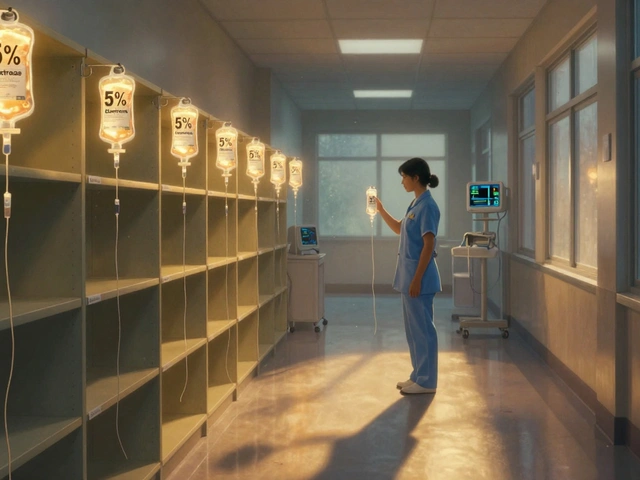Dabigatran Dosing Calculator
Determine Your Dabigatran Dose
Based on renal function (creatinine clearance), select the appropriate dabigatran dose.
When it comes to protecting the brain from clot‑related strokes, Dabigatran is a direct thrombin inhibitor that has become a cornerstone therapy for patients with atrial fibrillation. Unlike older anticoagulants that demand regular blood‑test monitoring, dabigatran offers a fixed‑dose regimen and a rapid onset of action, making it feel like a modern, hassle‑free shield for a high‑risk heart rhythm. This article walks through why doctors and patients alike consider dabigatran a game‑changer in stroke prevention.
Key Takeaways
- Dabigatran directly blocks thrombin, stopping clot formation at its source.
- The RE‑LY trial showed a 30% lower risk of ischemic stroke compared with warfarin.
- No routine INR monitoring is needed, but kidney function must be checked regularly.
- Idarucizumab provides a rapid, specific reversal for major bleeding.
- Cost is higher than warfarin, yet reduced hospitalizations often offset the price gap.
How Dabigatran Works: The Direct Thrombin Inhibition Pathway
Blood clotting is a cascade of enzymes converting fibrinogen into fibrin. Thrombin is the key enzyme that turns soluble fibrinogen into sticky fibrin strands. Dabigatran binds directly to thrombin’s active site, preventing it from cleaving fibrinogen. By stopping the final step, the drug stops clots before they can grow large enough to block cerebral arteries. This mechanism differs from vitamin K antagonists such as warfarin, which act earlier in the cascade and affect multiple clotting factors.
Clinical Evidence: What the RE‑LY Trial Told Us
The landmark RE‑LY (Randomized Evaluation of Long‑Term Anticoagulation Therapy) study enrolled over 18,000 patients with non‑valvular atrial fibrillation. Participants were randomized to dabigatran 110mg twice daily, dabigatran 150mg twice daily, or warfarin with a target INR of 2.0-3.0. After a median follow‑up of 2years, the 150mg dose cut the risk of ischemic stroke by 30% relative to warfarin, while the 110mg dose matched warfarin’s effectiveness but caused 20% fewer bleeding events. Importantly, dabigatran’s benefit was consistent across age groups, including patients over 80, who traditionally carry the highest stroke risk.

Side‑by‑Side: Dabigatran vs. Warfarin
| Aspect | Dabigatran | Warfarin |
|---|---|---|
| Mechanism | Direct thrombin inhibitor | Vitamin K antagonist |
| Typical Dose | 110mg or 150mg twice daily | 2-10mg once daily (adjusted by INR) |
| Monitoring | None required (periodic renal labs) | Frequent INR checks |
| Onset of Action | 30-60minutes | 48-72hours |
| Reversal Agent | Idarucizumab (Praxbind) | Vitamin K, prothrombin complex concentrates |
| Half‑Life | 12-17hours (renal clearance) | 20-60hours (hepatic metabolism) |
| Bleeding Risk | Lower intracranial, higher gastrointestinal | Higher intracranial, comparable GI |
| Cost (US, 2025) | $\$\$90‑120 per month | $\$5‑15 per month |
The table shows why many clinicians now start patients on dabigatran unless there’s a clear contraindication, such as severe renal impairment.
Practical Prescribing: Dosing, Renal Function, and Reversal
Because dabigatran is cleared primarily by the kidneys, estimating a patient’s creatinine clearance (CrCl) is essential. Standard dosing guidelines are:
- CrCl ≥50mL/min: 150mg twice daily (preferred for most).
- CrCl 30-49mL/min: 110mg twice daily (or 75mg in some regions).
- CrCr <30mL/min: generally avoid dabigatran; consider a dose‑adjusted warfarin or a factorXa inhibitor.
If a patient on dabigatran experiences a severe bleed or requires emergency surgery, idarucizumab is a monoclonal‑fragment antibody that binds dabigatran with picomolar affinity, neutralizing its effect within minutes. A typical dose is 5g administered intravenously, and the reversal is sustained for at least 24hours, allowing safe operative windows.
Who Gains the Most? Patient Selection Tips
Patients with a CHA₂DS₂‑VASc score of 2 or higher are candidates for anticoagulation. Dabigatran shines in sub‑groups such as:
- Older adults (≥75years) - the 110mg dose balances stroke protection with reduced bleed risk.
- Patients with a history of intracranial hemorrhage - dabigatran’s lower intracranial bleed rate offers peace of mind.
- Anyone frustrated by frequent INR clinic visits - the fixed‑dose regimen eliminates the logistics headache.
Conversely, avoid dabigatran in patients with:
- Severe renal dysfunction (CrCl <30mL/min).
- Active gastrointestinal ulcers (higher GI bleed risk).
- Known hypersensitivity to dabigatran or its excipients.

Managing Bleeding and Other Adverse Events
While dabigatran reduces the chance of catastrophic brain bleeds, it can cause dyspepsia and mild GI irritation. Simple measures help:
- Take the capsule with food or a full glass of water to lessen stomach upset.
- Monitor hemoglobin and stool occult blood if patients report black stools.
- Educate patients to call immediately if they notice unusual bruising or nosebleeds.
For non‑life‑threatening bleeds, holding the next dose and applying local measures often suffices. In true emergencies, call for idarucizumab and be ready to support with blood products if needed.
Future Directions: What’s Next for Anticoagulation?
Research continues to refine dabigatran’s role. Recent 2024 real‑world registries indicate that once‑daily formulations being studied could improve adherence further. Meanwhile, updated 2025 American Heart Association guidelines place dabigatran as a first‑line option alongside other direct oral anticoagulants (DOACs) for most patients with non‑valvular atrial fibrillation.
New agents targeting factorXa, such as betrixaban, are entering the market, but they still share many of dabigatran’s advantages: predictable pharmacokinetics and a specific reversal agent. For now, dabigatran remains the benchmark for stroke prevention, especially for those who value convenience and a lower risk of brain bleeds.
Frequently Asked Questions
Can I stop dabigatran before a routine doctor's appointment?
No. Dabigatran provides continuous protection against clot formation, so skipping a dose even for a day increases stroke risk. If you have a scheduled procedure, talk to your doctor about timing the next dose and whether a reversal agent is needed.
How often should kidney function be checked while on dabigatran?
At least annually for stable adults with normal renal function. For patients with borderline or declining kidney health, check every 6months or sooner if they develop symptoms of renal impairment.
Is there a generic version of dabigatran available?
As of 2025, no FDA‑approved generic equivalents exist in the U.S., though several manufacturers are awaiting patent expiry. Canada has approved a lower‑cost brand that follows the same pharmacology.
What should I do if I miss a dose?
Take the missed dose as soon as you remember, unless it’s within 6hours of the next scheduled dose. In that case, skip the missed one and continue with the regular schedule. Doubling up can raise bleeding risk.
Can dabigatran be taken with over‑the‑counter NSAIDs?
Combined use can increase gastrointestinal bleeding risk. If you need an NSAID, choose the lowest effective dose for the shortest time, and discuss alternatives like acetaminophen with your physician.






Comments
Terri DeLuca-MacMahon
15 October 2025Wow, dabigatran is truly a breakthrough!!! 🎉
No more endless INR checks, just a simple twice‑daily pill that kicks in fast.
It feels like we finally gave patients a hassle‑free shield against strokes.
Keep the momentum going, everyone! 🙌
gary kennemer
15 October 2025Reading through the mechanisms reminded me how elegant the coagulation cascade is-targeting the final step feels almost poetic.
Dabigatran’s direct inhibition of thrombin aligns nicely with the principle of minimal interference.
From a clinical philosophy standpoint, reducing monitoring burden also respects patient autonomy.
It’s a fine illustration of technology serving humanity without overcomplicating care.
Payton Haynes
15 October 2025Dabigatran works by blocking thrombin directly.
The drug was approved quickly after trials.
Some people think the pharma companies rushed it.
I wonder what they don’t tell us.
Earlene Kalman
16 October 2025Your poetic talk ignores the cold data.
The RE‑LY numbers show a 30% drop, but they hide the cost explosion.
Patients end up paying triple for a marginal benefit.
The system is built on profit, not health.
Brian Skehan
16 October 2025Everyone’s raving about the reversal agent Idarucizumab like it’s a miracle, but think about who manufactures it-big pharma has a monopoly on blood‑clot control.
They market the ‘no monitoring’ angle to lock us into pricey prescriptions while the real antidote is still under government secrecy.
Keep your eyes open; the next ‘innovation’ will cost even more.
Andrew J. Zak
16 October 2025It’s encouraging to see a medication that respects diverse lifestyles-no weekly clinic visits means patients in remote areas can stay safe.
The dosing simplicity fits well with varied cultural health practices, allowing clinicians to focus on education rather than logistics.
Let’s continue to share these advances globally.
Dominique Watson
16 October 2025The introduction of dabigatran represents a significant advancement for the Commonwealth’s approach to atrial fibrillation management.
While the United Kingdom has long championed evidence‑based therapies, the adoption of a drug with such a cost profile must be scrutinised against the National Health Service’s budgetary constraints.
Nonetheless, the clinical benefits cannot be dismissed outright.
Mia Michaelsen
16 October 2025Let’s set the record straight: dabigatran’s superiority isn’t a myth, it’s backed by robust phase‑III data.
The RE‑LY trial enrolled over 18,000 participants, demonstrating a statistically significant 30% reduction in ischemic stroke versus warfarin.
However, the higher gastrointestinal bleeding risk warrants vigilant monitoring of renal function.
In short, the drug is a game‑changer, but not without caveats.
Kat Mudd
16 October 2025Dabigatran is being sold as the miracle cure for atrial fibrillation but the reality is far messier than the glossy brochures suggest.
The drug’s price tag of ninety to one‑hundred twenty dollars a month is a steep climb for anyone without comprehensive insurance.
While the RE‑LY trial showed a 30 percent drop in ischemic stroke the study also revealed a noticeable uptick in gastrointestinal bleeding that many clinicians choose to downplay.
The reliance on renal function tests every few months adds a hidden layer of monitoring that defeats the ‘no‑lab’ hype.
Moreover the reversal agent idarucizumab is itself an expensive commodity that hospitals must stock at considerable cost.
Patients are told they can forget about INR checks but they are not warned that kidney function can deteriorate silently and jeopardise safety.
The marketing narrative conveniently omits the fact that in patients over 80 the benefit margin narrows considerably.
Real‑world data from community practices have begun to reveal adherence issues because the twice‑daily dosing schedule can be cumbersome for the elderly.
The pharmaceutical companies profit from a cycle that encourages perpetual prescribing without truly solving the underlying risk of stroke.
Insurance companies, in turn, push the drug forward to reduce hospital readmissions, creating a feedback loop that inflates usage numbers.
The whole system appears engineered to prioritize revenue streams over transparent patient outcomes.
If you look at the cost‑effectiveness analyses you will see that the lower hospitalization rates barely offset the drug’s premium price.
In many low‑resource settings clinicians still rely on warfarin because it is affordable and the reversal methods are widely available.
The narrative that dabigatran is universally superior is therefore an oversimplification that ignores socioeconomic disparities.
Until we have truly affordable, safe, and easy‑to‑monitor anticoagulants the debate will remain unresolved.
Pradeep kumar
16 October 2025From a pharmacokinetic perspective, dabigatran’s renal clearance (12–17 hours half‑life) mandates periodic creatinine clearance assessment to optimise dose intensity.
The 150 mg BID regimen achieves maximal thrombin inhibition, while the 110 mg BID protocol balances efficacy with reduced GI bleed risk in patients with moderate renal impairment.
Incorporating idarucizumab as a targeted reversal agent streamlines emergent bleed management, reducing time‑to‑hemostasis to under ten minutes.
Clinicians should therefore integrate renal function trends into shared decision‑making algorithms to personalise therapy.
James Waltrip
16 October 2025Ah, the saga of dabigatran reads like a modern‑day epic, where the valiant drug slays the dragon of inconvenient INR monitoring with a flamboyant flourish of direct thrombin inhibition.
Yet, lurking behind the glittering veneer lies the ever‑present shadow of pharmaceutical oligarchy, whispering sweet nothings about safety while clutching a gilded price tag.
One cannot help but marvel at the paradox: a molecule crafted with such precision, yet marketed with the subtlety of a brass band.
In any case, the clinical tableau is undeniably richer, provided we do not become intoxicated by the siren song of novelty.
Chinwendu Managwu
16 October 2025I love the excitement around dabigatran 😊 but let’s not forget that warfarin has saved countless lives for decades 🙃 its cheap price and well‑known reversal strategies still make it a solid choice for many patients.
Kevin Napier
16 October 2025Kat, you raise a lot of valid points about cost and monitoring, and it’s important to keep those concerns front‑and‑center.
At the same time, many patients truly appreciate the freedom from daily blood draws, and we have tools to manage renal checks efficiently.
Balancing affordability with safety is a shared challenge, and open dialogue like this helps move the conversation forward.
Sherine Mary
16 October 2025The hype ignores the hidden risks.